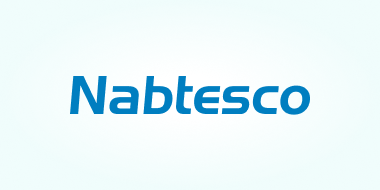
Labor Practice
Labor Management Relations
Labor Union
Nabtesco was established following the integration of Teijin Seiki Co., Ltd. and NABCO Ltd. in October 2004, and the labor unions of the two companies were united on October 30, 2010 to form the Nabtesco Labor Union (hereinafter referred to as the “Union”). The Union is a union shop system with approximately 2,000 members as of December 31, 2024, and serves as the representative of the majority in all domestic establishments. In December 2022, the Union welcomed as new labor union members post-retirement continuous employees who were previously ineligible for membership. This was done in order to absorb the voices of more workers and develop union activities to realize a secure and rewarding work environment.
The labor and management of Nabtesco maintains good relations with the union by jointly discussing ways to improve the company’s various systems and programs, regularly meeting to exchange opinions regarding business management, environment and occupational health and safety, and salaries and bonuses. The written agreement between the company and the union includes a clear statement on management’s obligations to make efforts to implement the no overtime day system and encourage employees to take planned annual paid leaves. The labor and management cooperate with the union to help maintain the work-life balance of its employees.
Labor Union Participation Rate (non-consolidated / as of Dec. 31, 2024)
80.1%
*The rate of employees who have the right to collective bargaining is the same as the labor union participation rate.
Protection of Freedom of Association and Right to Bargain Collectively
- 1.Labor-management meeting (twice a year)
- 2.In-house company labor-management meeting (twice a year)
- 3.Onsite labor-management meeting (every month)
- 4.Study meeting on personnel affairs and labor relations (three times a year)
Nabtesco holds labor-management meetings regularly with the labor union. Through these meetings the union obtains important information about the company’s management, which helps maintain sound labor-management relationships. In recent years, labor and management have been working together to resolve common labor-management issues through close communication on topics such as the introduction of a role-based personnel system, extension of the retirement age, work-style reform, and achievement of work-life balance. In addition, when both sides have proposals regarding working conditions and treatment of union members, we hold labor-management council meetings, and when there is disagreement, we make our best efforts to resolve the issue peacefully and protect the right to collective bargaining by accepting collective bargaining agreements.
In the collective labor agreement, Nabtesco approves that the labor union has the three rights of labor (the right to organize, the right to bargain collectively and the right to act collectively).
Guaranteeing Fair and Appropriate Compensation Levels
Nabtesco has introduced a role-based compensation system. We prioritize providing timely, appropriate rewards for employees’ roles and contributions, and strive to offer competitive, attractive compensation. As part of this approach, we participate in annual external compensation surveys to verify the appropriateness and competitiveness of our compensation levels based on benchmark data, while continuously operating and reviewing the system. For non-regular employees, we have established a compensation system that differs from that of regular employees; however, based on the principle of equal pay for equal work, we ensure an appropriate balance with regular employees’ compensation and provide a level that enables them to live with peace of mind. Through these initiatives, we are striving to achieve fair and appropriate compensation across the organization.
In addition, through agreements with the labor union, Nabtesco has established its own workplace-specific minimum wages that exceed the regional and industry-specific statutory minimum wages specified by the Minimum Wage Act. Based on these agreements, the company sets workplace-specific minimum wages by adding a fixed amount to the annually revised statutory minimum levels in principle. While workplace-specific minimum wages serve primarily as a safety net, they also provide employees with a sense of security and ensure compliance with relevant laws.
Also at the Nabtesco Group companies outside Japan, employee wage levels are set in accordance with laws stipulating minimum wages in the relevant country to ensure legal compliance.
Work-Life Balance
We expect that each employee maintains their mental and physical health, enhances their quality of work, plays their role at work while feeling a sense of fulfillment and satisfaction, and leads a satisfactory private life at home and in the community. We believe such a lifestyle will develop new values and concepts. Therefore, we have a wide spectrum of schemes in place to promote a healthy work-life balance. In 2016, we set up a special committee of labor and management that aimed to discuss and implement measures to contribute to work-life balance for higher productivity, diversified working styles, and appropriate control over work hours.
Activities Promoting Teleworking
We introduced a teleworking system, satellite office working system, and mobile working system to develop a work environment where our employees can flexibly choose the working time and workplace. We also have a flexible working system in place and have recently shortened the length of the core working hours to enable employees to choose even more flexible work styles. We will continue to promote the system, revise it according to usage conditions, and expand options, taking into account current trends of the world and internal needs.
Activities for Appropriate Control Over Work Hours
Today, businesses are required to handle more complex working time management with the popularization of mobile terminals and emergence of new working styles. In 2017, we developed a working time management handbook to standardize internal rules and consciousness.
In 2019, 2022 and 2024—every three years—we have also implemented an e-learning program, which covers topics from the working time management handbook, for all directors and managers. The IT-based monitoring function has been partially introduced.
Working hours are properly managed based on objective records, and appropriate statutory wages (overtime premiums) are paid for overtime work in accordance with laws and regulations. In addition, the status of annual paid leave taken and actual overtime hours are regularly reviewed by labor and management, and the findings are used to help prevent overwork and to improve the workplace environment.
Systems and tools are being developed to thoroughly control work hours based on objective recording and suppress excessively long work hours. In overseas sites, we are managing working hours appropriately in accordance with local laws and regulations.
Activities Promoting the Taking of Paid Annual Leave
In cooperation with the labor union, we have established a specific numeric goal of 80% or more of paid annual leave taken based on compliance with the law (36 Agreement). The labor and management committee regularly monitors the rate of paid annual leave taken by employees by designating July, August, October and November as the special months for taking planned annual leave and encouraging employees to take six days off during these periods.
Both the management and employees will continue to promote the use of paid annual leave to elevate the rate of use.
Percentage of paid annual leave taken



